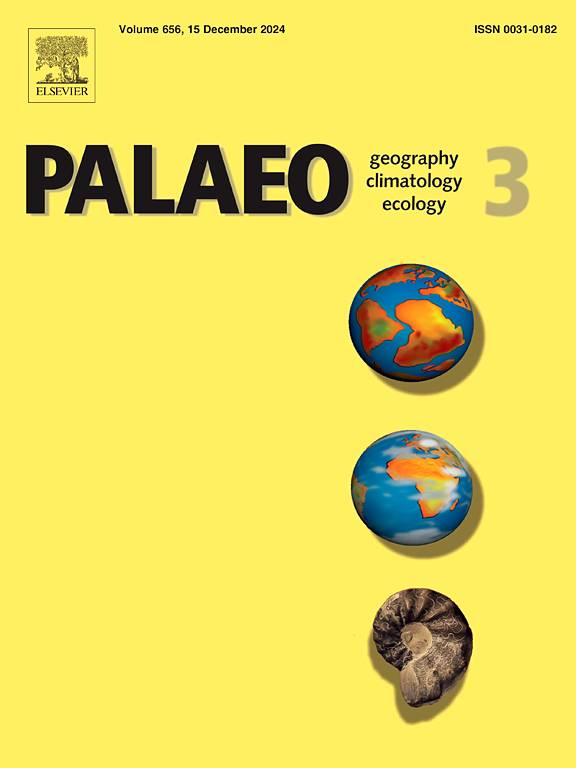全新世中期百年至几十年尺度的季风降水变率
IF 2.7
2区 地球科学
Q2 GEOGRAPHY, PHYSICAL
Palaeogeography, Palaeoclimatology, Palaeoecology
Pub Date : 2025-07-05
DOI:10.1016/j.palaeo.2025.113119
引用次数: 0
摘要
全新世中期的多年代际至百年气候变率和亚洲夏季风(ASM)的动态对于理解自然变率对全球变暖的贡献具有重要意义。本文报道了中国西南小山岩洞石笋XSY-G的1.7年分辨率和精确年代记录。我们的δ18O记录描述了早于现在(ka BP)的6.37 ~ 464千年的ASM强度和多年代际至百年际降水变化。结果显示在年代际到百年尺度上存在9个弱季风期(wmi),定义为超过1个标准差的偏移。这些wmi的中心位置约为6.20、6.03、5.78、5.66、5.54、5.38、5.15、4.98和4.74 ka BP,与附近高分辨率石笋记录的显著干旱相吻合。此外,还观测到330年、210年、128年、96年和79年的百年至十年周期。对现有石笋记录的验证表明,此次百年尺度的5.3 ka BP事件具有不对称双倾结构,持续时间为~ 340年,与北大西洋Bond 4事件的最强时期相对应。这些wmi可能与太阳活动和热带海面温度极小值有关,导致西南地区降水减少。我们的研究表明,在全新世中期,高纬度冷却和热带海洋-大气相互作用可能对海平面变化产生了叠加效应。本文章由计算机程序翻译,如有差异,请以英文原文为准。
Centennial- to multidecadal-scale monsoon precipitation variability during the mid-Holocene
Multidecadal to centennial climate variability and the dynamics of the Asian summer monsoon (ASM) in the mid-Holocene are important for understanding the contribution of natural variability to global warming. In this study, we present a 1.7-year resolution and precisely dated record of stalagmite XSY-G from Xiaoshanyan Cave, Southwest China. Our δ18O record depicts the ASM intensity and multidecadal to centennial precipitation variability from 6.37 to 4.64 thousand years before present (ka BP). The results reveal nine weak monsoon intervals (WMIs) at decadal to centennial scales, defined as excursions exceeding 1 standard deviation. These WMIs are centered at approximately 6.20, 6.03, 5.78, 5.66, 5.54, 5.38, 5.15, 4.98, and 4.74 ka BP, coinciding with notable droughts in the nearby high-resolution stalagmite record. Furthermore, centennial- to decadal-scale periodicities of 330-, 210-, 128-, 96- and 79-year are observed. The verification of existing stalagmite records reveals that the centennial-scale 5.3 ka BP event has an asymmetric double-plunging structure and a duration of ∼340 years, corresponding to the strongest period of Bond 4 event in North Atlantic. These WMIs are probably linked to solar activity and tropical sea surface temperature minima, resulting in decreased precipitation over Southwest China. Our study suggests that high-latitude cooling and tropical ocean-atmosphere interaction may have exerted superimposed effects on the ASM variability during the mid-Holocene.
求助全文
通过发布文献求助,成功后即可免费获取论文全文。
去求助
来源期刊
CiteScore
5.90
自引率
10.00%
发文量
398
审稿时长
3.8 months
期刊介绍:
Palaeogeography, Palaeoclimatology, Palaeoecology is an international medium for the publication of high quality and multidisciplinary, original studies and comprehensive reviews in the field of palaeo-environmental geology. The journal aims at bringing together data with global implications from research in the many different disciplines involved in palaeo-environmental investigations.
By cutting across the boundaries of established sciences, it provides an interdisciplinary forum where issues of general interest can be discussed.

 求助内容:
求助内容: 应助结果提醒方式:
应助结果提醒方式:


